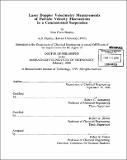| dc.contributor.advisor | Robert C. Armstrong and Robert A. Brown. | en_US |
| dc.contributor.author | Shapley, Nina C | en_US |
| dc.contributor.other | Massachusetts Institute of Technology. Dept. of Chemical Engineering. | en_US |
| dc.date.accessioned | 2006-05-15T20:23:06Z | |
| dc.date.available | 2006-05-15T20:23:06Z | |
| dc.date.copyright | 1999 | en_US |
| dc.date.issued | 2000 | en_US |
| dc.identifier.uri | http://hdl.handle.net/1721.1/32699 | |
| dc.description | Thesis (Ph.D.)--Massachusetts Institute of Technology, Dept. of Chemical Engineering, February 2000. | en_US |
| dc.description | Includes bibliographical references (p. 246-251). | en_US |
| dc.description.abstract | Recent statistical constitutive models of suspensions of neutrally buoyant, non-Brownian, non-colloidal, solid spheres in Newtonian fluids suggest that the particles nijgrate in response to gradients in "suspension temperature," defined as the average kinetic energy contained in the particle velocity fluctuations. These models have not yet been compared systematically with experimental data. In addition, the "temperature" models assume isotropic particle velocity fluctuations, since the "suspension temperature" is given as a scalar, in analogy to molecular systems. However, highly anisotropic particle velocity fluctuations have been observed in settling suspensions, which suggests that a "suspension temperature" tensor would be more realistic. We used laser Doppler velocimetry (LDV) to make a set of experimental observations of particle velocity fluctuations arising from inter-particle collisions in a concentrated non-colloidal suspension under nearly homogeneous shear flow in a narrow-gap concentric cylinder Couette device. We compared the relative sizes of the fluctuating velocity components and observed the variation of each component with particle volume fraction, shear rate, and radial position. In addition, we assessed the implications of these observations for suspension temperature models. The data indicate that the suspension temperature is anisotropic. The flow direction component is overwhelmingly the largest at every concentration and shear rate, followed by the neutral and then the gradient components. Meanwhile, each fluctuating velocity component demonstrates a distinct variation with the shear rate and with the particle volume fraction, but only slight variation with radial position, over the region of the flow accessible to measurement. Comparison between model predictions and measured shear rate and particle volume fraction profiles shows that several models capture the measured profiles qualitatively but not quantitatively, with better agreement for moderately concentrated suspensions than for highly concentrated suspensions. Also, comparison between predicted scalar suspension temperature profiles and the sum of the measured velocity fluctuation components demonstrates that most of the models underpredict the sum of the temperature components by a large factor. Finally, comparison among the models shows that the models are quite sensitive to the choice of transport coefficients that are functions of the particle volume fraction. | en_US |
| dc.description.statementofresponsibility | by Nina Claire Shapley. | en_US |
| dc.format.extent | 251 p. | en_US |
| dc.format.extent | 13812738 bytes | |
| dc.format.extent | 13829556 bytes | |
| dc.format.mimetype | application/pdf | |
| dc.format.mimetype | application/pdf | |
| dc.language.iso | eng | en_US |
| dc.publisher | Massachusetts Institute of Technology | en_US |
| dc.rights | M.I.T. theses are protected by copyright. They may be viewed from this source for any purpose, but reproduction or distribution in any format is prohibited without written permission. See provided URL for inquiries about permission. | en_US |
| dc.rights.uri | http://dspace.mit.edu/handle/1721.1/7582 | |
| dc.subject | Chemical Engineering. | en_US |
| dc.title | Laser Doppler velocimetry measurements of particle velocity fluctuations in a concentrated suspension | en_US |
| dc.title.alternative | LDV measurements of particle velocity fluctuations in a concentrated suspension | en_US |
| dc.type | Thesis | en_US |
| dc.description.degree | Ph.D. | en_US |
| dc.contributor.department | Massachusetts Institute of Technology. Department of Chemical Engineering | |
| dc.identifier.oclc | 45145579 | en_US |
